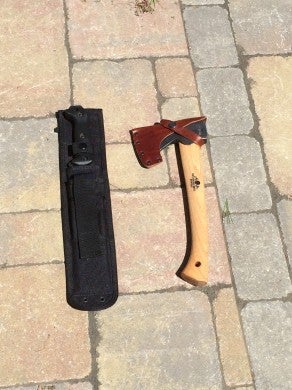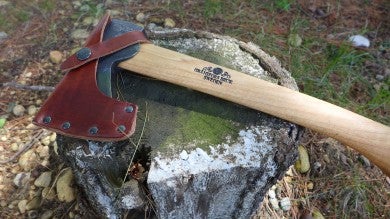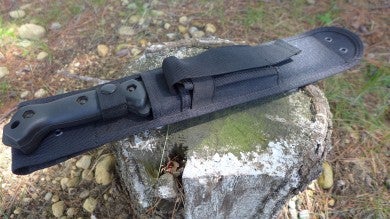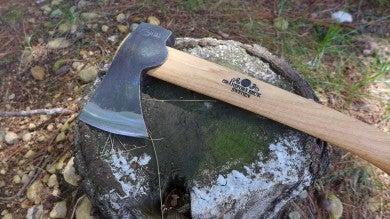A Newb’s Take on Chopper v. Hatchet, Part I
Tony Sculimbrene 10.30.14
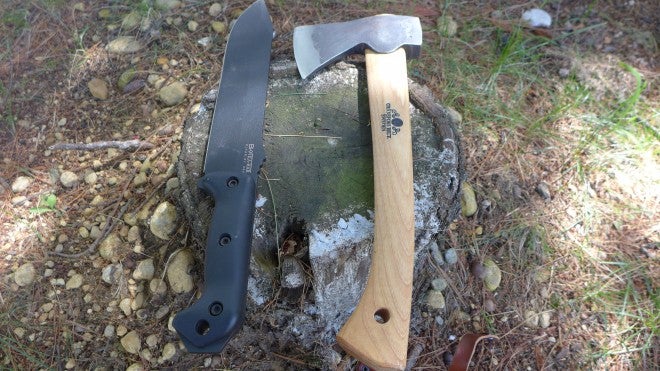
I wanted to take a close look at the debate that surrounds the utility of big, hard-use fixed blades–so called chopper knives. Unfortunately, I am not a mountain man, and my work with these knives is basically limited to chopping and splitting wood for my fire. I haven’t done any expedition work with a chopper, and frankly my skills compared to a lot of folks are quite limited. But I also think there are a lot of people in my position trying to figure out what to spend their hard earn money on, and the sources on the internet are so wildly divergent that they don’t provide a lot of guidance. Every once in a while someone will chime in on the debate and mention an axe or a hatchet as the superior choice. So I decided to get a good version of both and see what I liked better.
Like many seemingly eternal debates (pepperoni v. cheese, Coke v. Pepsi, and Star Trek v. Star Wars), there is a great deal of nuance that folks miss once they are entrenched on one side or the other. Choppers (big knives designed for hacking and chopping) are selling like hotcakes, but experienced people continue to trumpet the merits of a small axe or hatchet. I am still very new to this debate, not yet being able to carve tent stakes in no more than seven cuts, but in my three or so months using both a hatchet and a chopper, I have made a few observations that might help you decide where to come down on this debate.
There are a few caveats before we get to the lessons themselves.
First, don’t bother with cheap versions of either a chopper or an axe/hatchet. These items are going to be used in situations involving high energy, and a broken piece in that situation is a lot worse than a folder with a clip that falls off. Try to avoid anything less than $50. The Gerber choppers have been subject to multiple recalls, proof of the problem with cheap choppers. Likewise, the Gerber hatchet has been subject to recall as well. Here is more on the Gerber problem with recalls.
Second, it is much harder to find a good axe than it is to find a good chopper. Choppers are falling out of trees these days, driven in part by an obsession with zombies that I still don’t understand. ESEE, Ka Bar, Ontario, Cold Steel, and quite a few others make an abundance of good choppers. Higher end stuff exists, as well, from companies like Bark River, Survive Knives, and Busse. But axes are harder to find.
Skip the axe selection at Big Box stores. They are positively dreadful with painful to use handles, dull heads with awful geometry, and the worst bunk wood handles you can imagine. For the money, two brands to consider are Wetterling and Gransfor Bruks. I have handled both and have bought a GB, but both are good. GB stuff has a bit more refinement and finish to it compared to a Wetterling. You can find boutique axes, as well. Stuff from John Neeman looks very nice, but I would avoid premium axes from hipster stores, especially ones with painted handles.
Finally, don’t forget about the sheath; it’s really important, but a lot of times it is a total afterthought in terms of design.
Many choppers come in these generic cordura sheathes, and while some are okay, none are great. I’d strongly prefer a good leather or kydex sheath. Most good hatchets come with a good sheath. The GB hatchet I bought has a beautiful and ingeniously designed leather sheath.
The BK-9’s sheath is nowhere near as nice, but it does work better than many chopper sheathes out there.
I was going to include this in the caveats above, but it is so important that it deserves its own paragraph: avoid the deluge of tomahawks.
Tomahawks seem to be everywhere today. Cold Steel makes a few, CRKT makes some, there are positively a billion coming from budget brands and overseas producers. Benchmade even makes one. They usually have lower hardness carbon steels and thus are very inexpensive to produce, especially compared to their price tag (and to folders which are more complex to make and run more expensive steels).
The problem I have with almost all of them (having handled the SOG, the Benchmade, and one of the Cold Steel ‘hawks) is that they are weapons first and wood chopping tools second. You can see this most evidently in the edge geometry. They are exceptionally thin and many have hollow or even full flat grinds. They lack the robust, convex edge of a GB axe. As a result they would not handle wood chopping and cutting tasks as well as a dedicated axe. Their thin edges won’t “pop” the wood like a convex or wide flat grind would. So while they probably could be pressed into service as a wood chopping device, they are primarily a weapon. Having handled a few GB and Wetterlings, I think they’d make a decent weapon too, but they are better designed for the task you are most likely to do with your axe: chopping and splitting wood. Skip the tomahawks and get a real axe or hatchet.
Lesson #1: It’s all About Your Skills
Lots of us grew up using knives. Fewer grew up with axes and hatchets. And those that did will probably agree with this statement: axes and hatchets were among the last tools our parents let us use, and for good reason. A knife has a much more even distribution of weight, making it is easier for a person to control, but the huge mass at the end of an axe or hatchet not only makes what it is, it also makes it harder to control. I started out with a bow saw, then graduated to a cheap machete, and only when I was teenager and had a good deal of control and more muscle did I graduate to an axe or hatchet. In the wood cutting spectrum, only the chain saw is after the axe or hatchet, both in terms of use progression and danger.
This means that folks probably don’t have as much experience with an axe or hatchet as they do with a knife. This led me to be more biased to a chopper over an axe. I have had a big chopper for years now and have used it a lot. I just felt more comfortable and I have more control. But the reality is that an axe is just less work to use.
Instead of banging on a tree for a half an hour, a few swings of an axe can fell that same stubborn plant. All of this, however, requires the development of skill.
Compare two people, someone that makes a living or survives through the use of a chopper and someone that grew up with an axe. Both can do just about whatever they need to do with their respective tools, and more to the point, both can do what the other can do with their respective tools. In the hands of an experienced user, a chopper and an axe are almost equally capable, and this is because they have the skills necessary to make their tools really work.
More on the important differences between the two in Part II.
